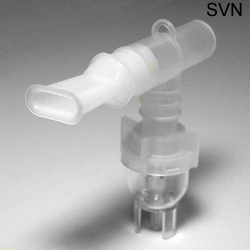:: Section 5
SVN (Small-Volume Nebulizers)
A nebulizer is a device used to deliver medicine to the airways in forms of a liquid mist. Gas-powered jet nebulizers have been in clinical use for more than 100 years. Also called "atomizers", they pump air or oxygen through a liquid medicine to turn it into aerosol, which is then inhaled by the patient. The pressure can be provided by a portable compressor, compressed gas cylinder, or 50-psi wall outlet. It is used to deliver aerosolized drugs to the respiratory tract and also used to produce water mists to humidify dry inspired gases. Another main function is to improve mobilization and clearance of respiratory secretions, e.g., sputum induction, using bland aerosols of water and hypertonic or hypotonic saline. An effective pneumatic nebulizer should be able to deliver more than 50% of its total dose in the respirable range in 10 minutes or less of nebulization time. Because nebulizers commonly used at home and in the hospital for drug administration have small ( smaller than or equal to 10 mL) medication reservoirs, they are called Small-Volume Nebulizers (SVNs).
Since SVNs required neither a high breathing rate nor hand-breathing coordination, they can be used by infants or patients in acute respiratory distress. Furthermore, dose delivery by the SVN occurs over 60 to 90 breaths, rather than in only one or two inhalations. Thus a single ineffective breath will not destroy the efficacy of the treatment.
 |
|
